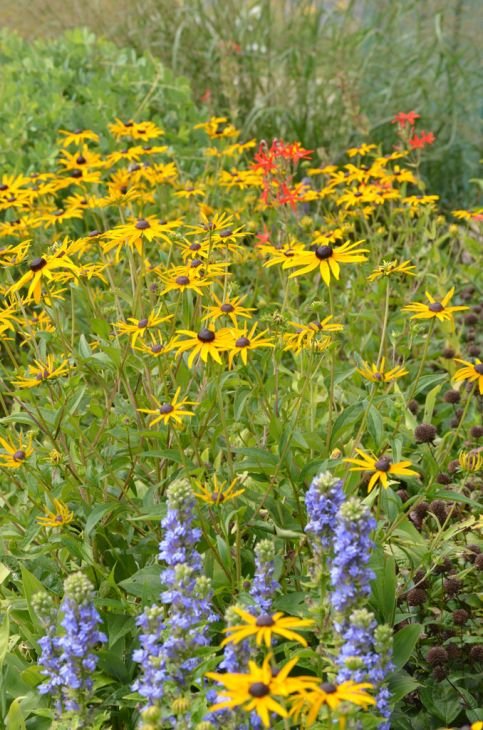Rudbeckia fulgida, Orange Coneflower
Rudbeckia fulgida, Orange Coneflower
FS - PS, Zone 3, Blooms July - Sept., 3’ x 2’, medium-wet - medium-dry, deer resistant
Rudbeckias are a keystone plant. This means they are a native that supports more caterpillar and specialist bee species than other plants.
The plant grows from rizome network of roots. In spite of this, the plant is fairly well behaved and forms more of a nicely mounded dome. It can be controlled through division. Share the extras with others. Like many native, be sure to keep it watered until established. Once established, Orange coneflower can handle drought.
It supports many butterflies and moth species including the Silvery Checkerspot, Chlosyne nycteis and the Wavy-Lined Emerald(Synchlora aerata). This plant supports so many native bees including 25 species of specialist bees. All the caterpillars on Rudbeckia support birds as well as the seeds available late season.
This plant is new to our nursery in 2025. Current photos are from Prairie Moon Nursery until we can take DA photos. Prairie Moon has a terrific web site and clear, consistent directions for seed starting. Check them out - https://www.prairiemoon.com/
Rudbeckia fulgida, Orange Coneflower
FS - PS, Zone 3, Blooms July - Sept., 3’ x 2’, medium-wet - medium-dry, deer resistant
Rudbeckias are a keystone plant. This means they are a native that supports more caterpillar and specialist bee species than other plants.
The plant grows from rizome network of roots. In spite of this, the plant is fairly well behaved and forms more of a nicely mounded dome. It can be controlled through division. Share the extras with others. Like many native, be sure to keep it watered until established. Once established, Orange coneflower can handle drought.
It supports many butterflies and moth species including the Silvery Checkerspot, Chlosyne nycteis and the Wavy-Lined Emerald(Synchlora aerata). This plant supports so many native bees including 25 species of specialist bees. All the caterpillars on Rudbeckia support birds as well as the seeds available late season.
This plant is new to our nursery in 2025. Current photos are from Prairie Moon Nursery until we can take DA photos. Prairie Moon has a terrific web site and clear, consistent directions for seed starting. Check them out - https://www.prairiemoon.com/
Rudbeckia fulgida, Orange Coneflower
FS - PS, Zone 3, Blooms July - Sept., 3’ x 2’, medium-wet - medium-dry, deer resistant
Rudbeckias are a keystone plant. This means they are a native that supports more caterpillar and specialist bee species than other plants.
The plant grows from rizome network of roots. In spite of this, the plant is fairly well behaved and forms more of a nicely mounded dome. It can be controlled through division. Share the extras with others. Like many native, be sure to keep it watered until established. Once established, Orange coneflower can handle drought.
It supports many butterflies and moth species including the Silvery Checkerspot, Chlosyne nycteis and the Wavy-Lined Emerald(Synchlora aerata). This plant supports so many native bees including 25 species of specialist bees. All the caterpillars on Rudbeckia support birds as well as the seeds available late season.
This plant is new to our nursery in 2025. Current photos are from Prairie Moon Nursery until we can take DA photos. Prairie Moon has a terrific web site and clear, consistent directions for seed starting. Check them out - https://www.prairiemoon.com/

